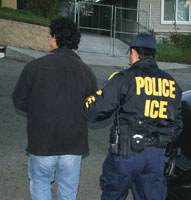
ICE arrests an illegal worker. Source ICE.
Loughran says federal investigatory and prosecutorial tactics of worksite enforcement at food processors has evolved from the ineffective prosecution of Tyson Foods and six Tyson employees in 2001 to the current practice of “working up the chain,” by raiding worksites and arresting ground-level workers to collect evidence against the employer and its higher-level employees. This ground-up approach, says Loughran, was used in massive work raids conducted at Swift & Co. in 2006, as well as Pilgrim’s Pride and AgriProcessors in 2008.
To avoid employment sanctions, civil liability and criminal charges, the government has introduced electronic employment verification databases by which employers can determine whether an individual is authorized to work in the US. Evidence uncovered during ICE investigations, however, has shown that these databases are not perfect in guarding employers against the hire of illegal aliens, as large numbers of illegal aliens have assumed the identities of US citizens or lawful, permanent US residents to gain employment.
As employers are legally required to accept work documents appearing to be genuine, the presence of illegal employees doesn’t necessarily mean the employer is complicit in hiring and harboring unauthorized workers. Moreover, says Loughran, “An overreaction by an employer leading to excessive employment verification to meet stepped-up federal enforcement can create significant discriminatory liability.”
Loughran suggests there is a way for processors to reduce the risk of an ICE raid and scrutiny from an unusually high number of employment rejections. “Qualified review of I-9 documents is key. An I-9 review should include exposure analysis, supervised remediation and policy implementation. A thorough examination of the employment authorization of all existing employees is also important, with routine re-verification conducted on a regular basis.”